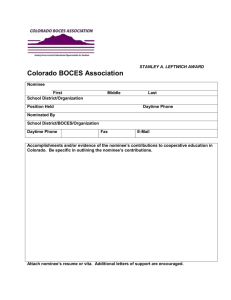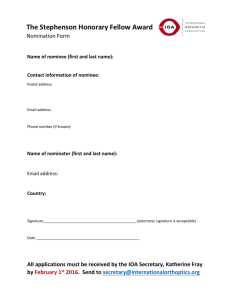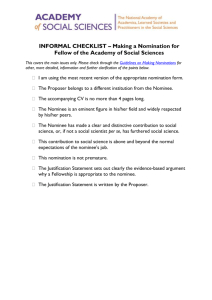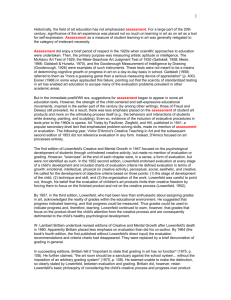State - National Art Education Association
advertisement
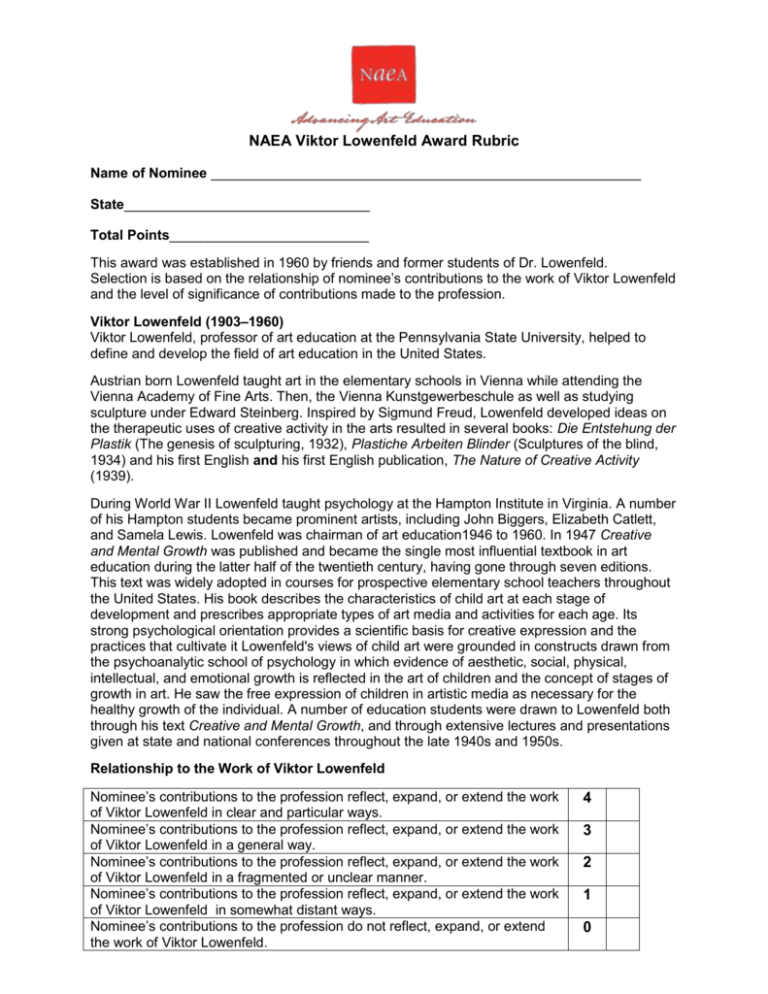
NAEA Viktor Lowenfeld Award Rubric Name of Nominee ________________________________________________________ State________________________________ Total Points__________________________ This award was established in 1960 by friends and former students of Dr. Lowenfeld. Selection is based on the relationship of nominee’s contributions to the work of Viktor Lowenfeld and the level of significance of contributions made to the profession. Viktor Lowenfeld (1903–1960) Viktor Lowenfeld, professor of art education at the Pennsylvania State University, helped to define and develop the field of art education in the United States. Austrian born Lowenfeld taught art in the elementary schools in Vienna while attending the Vienna Academy of Fine Arts. Then, the Vienna Kunstgewerbeschule as well as studying sculpture under Edward Steinberg. Inspired by Sigmund Freud, Lowenfeld developed ideas on the therapeutic uses of creative activity in the arts resulted in several books: Die Entstehung der Plastik (The genesis of sculpturing, 1932), Plastiche Arbeiten Blinder (Sculptures of the blind, 1934) and his first English and his first English publication, The Nature of Creative Activity (1939). During World War II Lowenfeld taught psychology at the Hampton Institute in Virginia. A number of his Hampton students became prominent artists, including John Biggers, Elizabeth Catlett, and Samela Lewis. Lowenfeld was chairman of art education1946 to 1960. In 1947 Creative and Mental Growth was published and became the single most influential textbook in art education during the latter half of the twentieth century, having gone through seven editions. This text was widely adopted in courses for prospective elementary school teachers throughout the United States. His book describes the characteristics of child art at each stage of development and prescribes appropriate types of art media and activities for each age. Its strong psychological orientation provides a scientific basis for creative expression and the practices that cultivate it Lowenfeld's views of child art were grounded in constructs drawn from the psychoanalytic school of psychology in which evidence of aesthetic, social, physical, intellectual, and emotional growth is reflected in the art of children and the concept of stages of growth in art. He saw the free expression of children in artistic media as necessary for the healthy growth of the individual. A number of education students were drawn to Lowenfeld both through his text Creative and Mental Growth, and through extensive lectures and presentations given at state and national conferences throughout the late 1940s and 1950s. Relationship to the Work of Viktor Lowenfeld Nominee’s contributions to the profession reflect, expand, or extend the work of Viktor Lowenfeld in clear and particular ways. Nominee’s contributions to the profession reflect, expand, or extend the work of Viktor Lowenfeld in a general way. Nominee’s contributions to the profession reflect, expand, or extend the work of Viktor Lowenfeld in a fragmented or unclear manner. Nominee’s contributions to the profession reflect, expand, or extend the work of Viktor Lowenfeld in somewhat distant ways. Nominee’s contributions to the profession do not reflect, expand, or extend the work of Viktor Lowenfeld. 4 3 2 1 0 NAEA Viktor Lowenfeld Award Rubric Contributions to the Profession: Nominee has made significant contributions through research, teaching, and/or leadership. Nominee has made some contributions through research, teaching, and/or leadership. Nominee has made minor contributions through research, teaching, and/or leadership. Nominee has made some contributions through one area – either: research, teaching, or leadership. Nominee has made no contributions through research, teaching, and/or leadership. 4 3 2 1 0 Letters of support: Nominee’s letters of support provide superior evidence of advancing the cause of art education. Nominee’s letters of support provide moderate evidence of advancing the cause of art education. Nominee’s letters of support provide limited evidence of advancing the cause of art education. Nominee’s letters of support provide no evidence of advancing the cause of art education. 5 3 2 0 Comments – Please provide up to 5 points/comments that are specific to the work of the nominee to help clarify why this person should receive this award.



